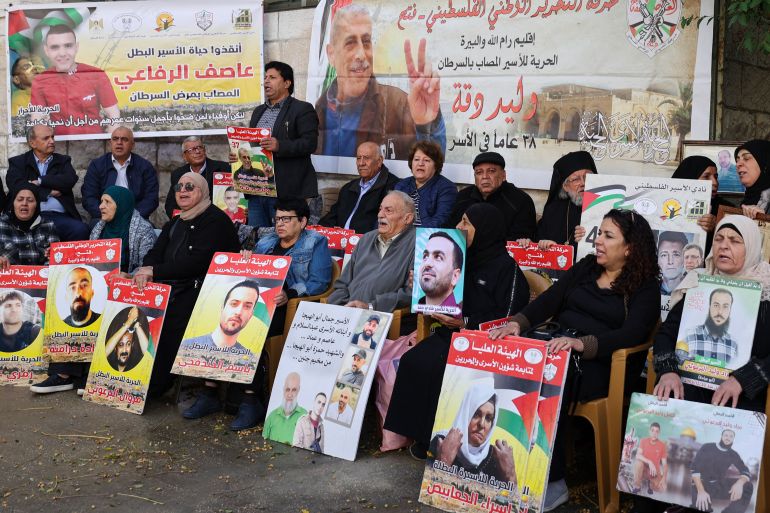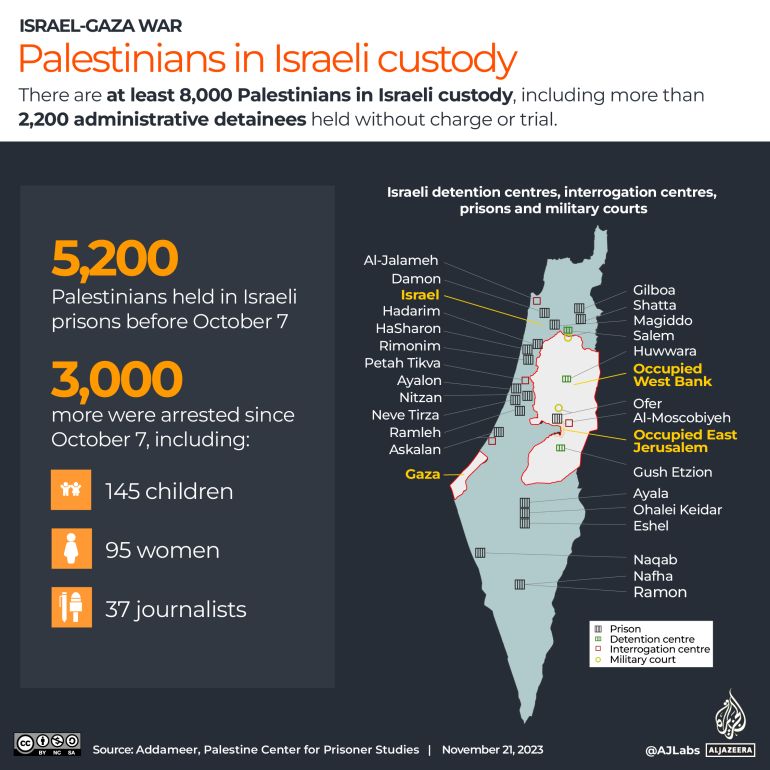Thirty-nine Palestinian women and children are expected to be released from Israeli jails on Friday during a pause in fighting.

After seven weeks of war, the four-day truce between Israel and Hamas began on Friday morning. Under this truce, 39 Palestinian women and children were released on Friday.
Here is what’s known about those released and those who might be released in the coming days.
KEEP READING
list of 4 itemslist 1 of 4
Over 10,000 Palestinian prisoners held in Israeli jails
list 2 of 4
Prisoner exchange? Israeli captive families demand answers from Netanyahu
list 3 of 4
Israel-Hamas deal: Which captives, Palestinian prisoners could be freed?
list 4 of 4
Anxious, optimistic: Families of female Palestinian prisoners await release
end of list
Who were the prisoners released on Friday?
Of the 39 Palestinians released by Israel, 17 are minors.
They are:
- Yousef Mohammad Mustafa Ata from Ramallah
- Qusai Hani Ali Ahmad from Bethlehem
- Jibreel Ghassan Ismail Jibreel from Qalqilya
- Mohammad Ahmad Suleiman Abu Rajab from al-Khalil
- Ahmad Nu’man Ahmad Abu Na’im from Ramallah
- Baraa Bilal Mahmoud Rabee from al-Khalil
- Aban Iyad Mohammad Said Hammad from Qalqilya
- Moataz Hatem Moussa Abu Aram from al-Khalil
- Iyad Abdul Qader Mohammad Khateeb from Jerusalem
- Hazma Laith Khalil Othman Othman from Ramallah
- Mohammad Mahmoud Ayoub Dar Darwish from Ramallah
- Jamal Khalil Jamal Barahmeh from Areeha
- Jamal Yousef Jamal Abu Hamdan from Nablus
- Mohammad Anis Saleem Tarabi from Nablus
- Abdul Rahman Abdul Rahman Suleiman Rizq from Jerusalem
- Zeina Raed Abdou from Jerusalem
- Noor Mohammad Hafez al-Tahir from Nablus
Zeina and Noor are girls, the others are boys.
The remaining 22 of the Palestinians released on Friday are women. They are:
- Rawan Nafez Mohammad Abu Matar from Ramallah
- Marah Joudat Moussa Bakeer from Jerusalem
- Malak Mohammad Yousef Suleiman from Jerusalem
- Amani Khaled Nu’man Hasheem from Jerusalem
- Nihaya Khader Hussein Sawan from Jerusalem
- Fayrouz Fayez Mahmoud al-Baw from Jerusalem
- Tahreer Adnan Mohammad Abu Suriya from Nablus
- Falasteen Fareed Abdul Latif Najm from Nablus
- Walaa Khaled Fawzi Tanja from Tulkarem
- Maryam Khaled Abdul Majid Arafat from Nablus
- Asil Muneer Ibrahim al-Tayti from Nablus
- Azhar Thaer Bakr Assaf from Jerusalem
- Raghd Nashat Salah al-Fanni from Tulkarem
- Fatima Nu’man Ali Badr from Jerusalem
- Rawda Moussa Abdul Qader Abu Ujaima from Bethlehem
- Sara Ayman Abdul Aziz Abdullah al-Suweisa from Nablus
- Fatima Ismail Abdul Rahman Shahin from Bethlehem
- Samira Abdul Harbawi from Jerusalem
- Samah Bilal Abdul Rahman Souf from Qalqilya
- Fatima Bakr Moussa Abu Shalal from Nablus
- Hanan Saleh Abdullah al-Barghouthi from Ramallah
- Fatima Nasr Mohammad Amarnah from Jenin
When and how were they released?
They were transferred from Israeli prisons to the Israel-controlled Ofer prison in the occupied West Bank in the early evening.
At 8pm local time (18:00 GMT), they were released from Ofer in International Committee of the Red Cross buses.
Who might be released next?
Israel has agreed to release 150 Palestinian women and children prisoners from its jails in exchange for Hamas releasing 50 of the women and children taken captive during the October 7 attack.
But the Israeli Ministry of Justice presented a list of 300 Palestinian prisoners who it is considering for release. It is unclear whether this might be an offer for a potential second phase of exchanges since the deal allows for the extension of a pause in fighting by one day for every 10 additional captives Hamas releases.
The list of 300 comprises 33 women. The majority of the rest of the names are of boys aged 16-18. However, there are also boys as young as 14 on the list.
Most of the prisoners on the list were arrested between 2021 and 2023. The prisoners arrested in 2023 were taken before October 7.
However, it also includes individuals like Shorouq Dwayyat, who was arrested in 2015 and is serving the ninth year of her 16-year sentence. Dwayyat is currently serving the longest sentence among Palestinian female prisoners in Israeli jails.
She was 18 when she was arrested and held in the Damon prison in Haifa, accused of stabbing an Israeli settler with a knife. Her family, anxiously anticipating her release, denies these accusations. “Shorouq is delicate and cannot harm an animal,” her father, Salah Dwayyat, told Al Jazeera at the time.

Why are they in prison?
Like Dwayyat, many other prisoners have been convicted of crimes including carrying and manufacturing knives and daggers. Other common offences detailed in Israel’s list include:
- threatening security
- illegally entering Israel without a permit
- throwing stones
- supporting terrorism
- associating with hostile/unknown organisations.
“The main alleged crime for these detentions is stone-throwing, which can carry a 20-year sentence in prison for Palestinian children,” said a report published in July by children’s rights organisation, Save the Children.
Israeli publication Haaretz reported that Israel has refused to release people convicted of murder but those convicted of attempted murder could be released.
Where will the Palestinian prisoners go after their release?
Under the deal, Palestinian prisoners will be taken from two Israeli prisons southeast of Haifa, namely Damon and Megiddo. They will then be taken to Israel’s military Ofer prison.
There, they will be handed over to the International Committee of the Red Cross and after they are received, “the ones from Jerusalem will go to Jerusalem, and the ones from the West Bank will gather in Betunia municipal council where their families will be waiting”, added Fares.
Israel has barred celebrations in Palestinian communities over the return of prisoners.
How many Palestinian prisoners are in Israeli jails?
There are 19 prisons within Israel and one inside the occupied West Bank holding Palestinian prisoners.
Before October 7, there were about 5,200 Palestinians in Israeli custody. However, following the Hamas attack of October 7, the number of Palestinians arrested skyrocketed and 3,000 more were arrested.

Of those arrested after October 7, 37 are journalists. Palestinian prisoner support and human rights association Addameer reported that most of these journalists were subjected to administrative detention, which means they are held indefinitely behind bars without facing trial or charges.
Addameer also reported that the detainees are subjected to physical violence and medical negligence in prisons. The report cited an example of a prisoner who suffers from blood disease and asthma. The prisoner was assaulted, resulting in wounds and bruises on his head and eyes. The association reported that this prisoner has lost 10kg since his arrest.

Some Palestinian prisoners have been in Israeli jails for more than 30 years, since before the Oslo Accords were signed. The term “deans of prisoners” is sometimes locally used to refer to them, reported Samidoun, an international Palestinian prisoner solidarity network.
At least 700 Palestinian children under the age of 18 from the occupied West Bank are prosecuted every year through Israeli military courts after being arrested, interrogated and detained by the Israeli army.
Children in Israeli detention often suffer physical, psychological and sexual abuse, and some are deprived of food, water and sleep, according to Save the Children.
https://imasdk.googleapis.com/js/core/bridge3.605.0_en.html#goog_1800504283Play Video
Stolen childhoods: Hundreds of Palestinian minors held in Israeli jails
